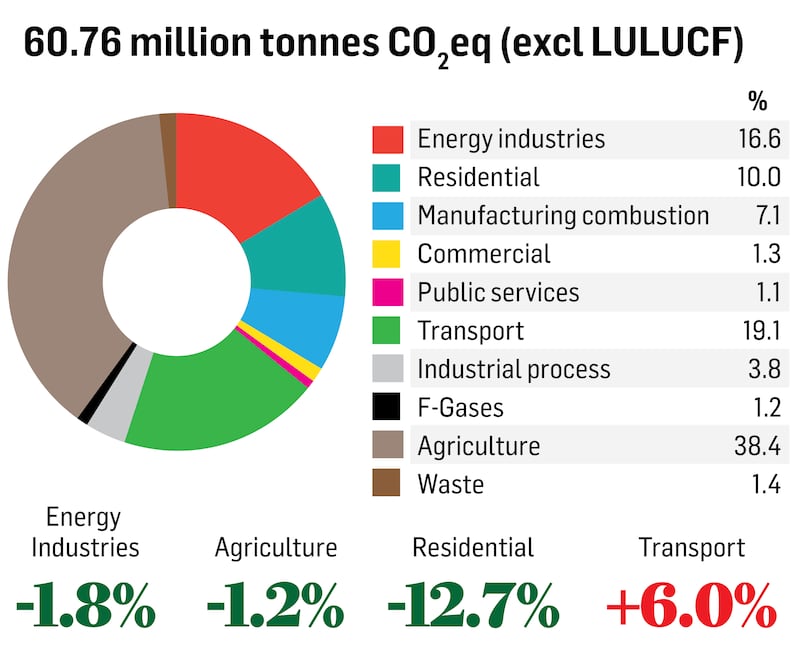Ireland’s greenhouse gas emissions decreased by 1.9 per cent in 2022, according to the Environmental Protection Agreement (EPA) – driven by higher fuel prices, increased renewable energy, behavioural change and regulation.
This includes a small reduction in agriculture emissions for the first time in many years. Transport is now emerging as the problem sector – rising 6 per cent last year.
The data in the latest emissions inventory indicates Ireland is beginning to force its overall emissions down, but 47 per cent of Ireland’s carbon budget for 2021-2025 has been used in the first two years. The budget attempts to contain sectoral emissions to within set limits.
[ EU emissions rules unfair on ordinary air passengers, says MinisterOpens in new window ]
“An extremely challenging annual reduction of 12.4 per cent is required for each of the remaining years” if Ireland is to stay within a legally binding budget, the EPA has warned. The Government has an overall 51 per cent reduction target for 2030 from a 2018 baseline.
READ MORE
The 2022 reduction resulted from power-generation emissions decreasing by 1.9 per cent due to a reduction in coal, oil and peat use, and more renewable energy. Agriculture emissions decreased by 1.2 per cent, driven by reduced fertiliser use, which offset the impact of an increase in livestock numbers.
Residential emissions decreased by 12.7 per cent, with the impact of higher fuel prices, new regulations banning smoky fuel and milder weather evident. The transport increase was because “the Covid rebound continues”.
In total, 60.76 million tonnes of carbon dioxide equivalent (MtCO2eq) were emitted, excluding emissions from land use, land use change and forestry, known as LULUCF, which are accounted for separately.
[ The Irish Times view on a record week of temperatures: an ominous indicatorOpens in new window ]
The figures also show Ireland exceeded its 2022 annual limit under the EU’s Effort Sharing Regulation. These annual limits have been reduced further from 2023 onwards as Ireland’s effort-sharing commitment increased from a 30 per cent reduction on the 2005 level by 2030 to a 42 per cent reduction.

A summary of key sectors shows:
Energy Industries: Emissions decreased despite a 2.1 per cent increase in overall electricity demand. The reductions driven by reductions in coal, oil and peat used in power generation were largely offset by the highest gas usage since 2010.
Agriculture: Emissions overall decreased by 0.29 MtCO2eq, including “a welcome decrease of 14 per cent in nitrogen fertiliser use”, to 343,000 tonnes, making significant progress towards the 330,000 tonne target for 2025 in the Government’s climate plan. This resulted in 0.44 MtCO2eq less emissions, but this was offset by the impact of higher dairy cow numbers which increased for the 12th successive year.
Residential: Emissions decreased to 6.1 MtCO2eq – the single largest cut of any sector. The main drivers for the decrease included a large rise in fossil fuel prices, warmer weather and new nationwide solid fuel regulations banning use of smoky fuel in home heating.
Transport: Emissions increased to 11.63 MtCO2eq, following a similar increase in 2021. Overall, higher transport activity – both private cars and freight transport – is eroding the impact of electric vehicles. In 2022, there were 72,000 battery electric (BEVs) and plug-in hybrid electric (PHEVs); approximately 37 per cent of the climate target for 2025. Emissions in this sector in 2022 were 4.6 per cent below the pre-pandemic level seen in 2019.
LULUCF: This sector accounted for 10.7 per cent of total emissions in 2022 and decreased by 0.5 per cent. The main source is from grasslands on organic soils that have been drained for agricultural production. Net grassland emissions were 6.8MtCO2eq in 2022, while forest land became a net source of carbon (0.4 MtCO2eq) as more trees reached harvesting age.
It is the long-standing convention for greenhouse gas reporting, in Ireland and internationally, that when referring to “total emissions” this means emissions excluding the LULUCF sector, though it is included in the national carbon budgets.
One of the reasons for this convention is that emissions/removals from the LULUCF sector can be very variable from country to country, are quite changeable from year to year and have the highest uncertainty. Countries, such as Sweden, with large forested areas can have very low per capita emissions that makes comparison with other countries difficult. For that reason, to assist when comparing per capita emissions across countries, it is more informative to use the excluded LULUCF total.
The emissions inventory 1990 to 2022 and breakdown by sector is available at epa.ie












